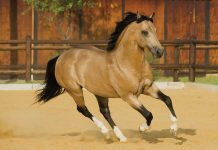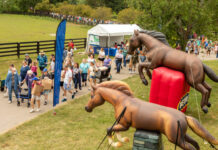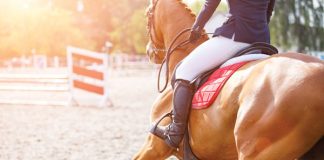If you love popping over fences, you are guaranteed to like gymnastics—sometimes called gridwork. Gymnastics are jumping exercises that benefit both you and your horse. You set up a line of carefully spaced fences and poles (a grid) and jump them with your horse. If a grid is set up properly, with the correct spacing between jumps, your horse should jump it easily.
Grids can build up your horse’s confidence. If he’s a spooky jumper or refuses a lot, grids can improve his jumping.
Grids are good exercise for your horse. They make him more flexible.
Grids can build your confidence, too. Because most horses find them easy, you can concentrate on your riding position.
Setting Up A Grid
The most important thing you’ll need when jumping a grid is…a helper! A person on the ground watches you jump, and adjusts the distances between the fences if your horse is having trouble jumping the grid.
Set up a simple grid with four fences. Simple cross-pole fences are fine. You’ll need an extra placing pole to put in front of the first fence, too. The fences should be one stride apart. This means that your horse lands after the fence, takes one stride, then takes off again over the next fence.
It’s important to set distances that are perfect for your horse. If your horse takes two strides between the fences, stumbles or jumps too big, your helper needs to move the jumps closer together or farther apart. Don’t make your horse jump bad distances, because you’ll ruin his confidence. And remember, a pony has shorter strides than a horse, so if you are riding with a friend on a pony, you won’t be able to jump the same grid.
Distances
All of these distances are approximate. You’ll probably have to adjust these to suit your horse or pony.
Horses: Put a placing pole on the ground 9 feet in front of the first fence, then each fence should be approximately 17-18 feet apart.
Small horses, large ponies: Put a placing pole 81/2 feet in front of the first fence, then each fence should be about 16-17 feet apart.
Small ponies: Put a placing pole 7-8 feet in front of the first fence, then each fence should be about 14-15 feet apart.
1. The first time you do a grid, it should be made of simple trotting poles. The poles should be on the ground between the jump standards. After you’ve warmed up your pony on the flat, start your gridwork. Make sure your pony is trotting at a nice, active pace, and then head for the grid. Get in jumping position before you get to the placing pole. Then, keep your legs on your horse, soften your hold on the reins and aim toward the middle of the poles.
If your horse trips or knocks a pole, he may be going too slowly. Or the poles may not be quite the right distance for him. If he trips up the second time you do the grid, your helper must move the poles to make it easier for him.
Don’t let your horse canter. Make him trot all the way through the grid.
2. Once you’ve been through the trotting pole grid several times, ask your helper to put up a small cross-pole at the end. It’s likely that your horse will want to canter over the tiny jump at the end, and you can let him. Sit quietly and let him figure out the grid for himself. It’s OK to trot in and canter out. Just keep your legs on your horse so he keeps moving forward.
3. Now the grid can get a bit more complicated. Get your helper to put up the first cross-pole, so your horse jumps in, trots over two poles and then jumps out. If the distances are correct, he should have no problem getting one stride between each fence. If he jumps the grid nicely once or twice, you can add other cross-poles, until he is finally jumping a whole row of cross-poles.
4. Finish up by making the last fence a small vertical. If your horse has been jumping smoothly through the previous grids, he should jump the vertical nicely, too. After you’ve popped over the vertical once or twice, make the second to last fence a vertical, too.
You can play around with grids, and change them as much as you want. But remember, grids are tiring for your horse, and you shouldn’t do them more than once a week. And always be flexible — if a distance isn’t working out, and your horse is stumbling or jumping awkwardly, move the fence right away so he’ll be able to jump it nicely.
Thanks to Marty and Jan Whitehouse and Critter Control of Red Gate Farm, Lexington, KY for their help with this feature.





